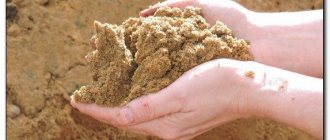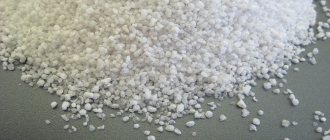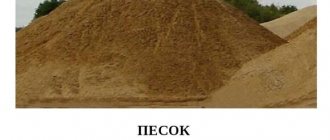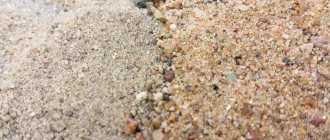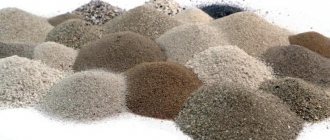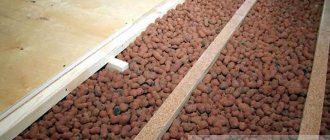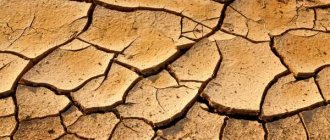Sand is the most popular screed material. It is used as a component of concrete mortar or for a cushion under a multi-layer floor. Much less often the material is used in dry screeds. It is recommended to buy alluvial quarry or river sand, with a grain size from 2.5 to 3.5 mm. Quartz sand is also suitable for screeding, but it is more expensive.
Sand is suitable for all types of screed:
- Wet
- Semi-dry
- Dry
Wet and semi-dry screeds consist of cement and sand in a ratio of 1:3. The difference between the two types of coating is the consistency and amount of water. A wet screed resembles thick sour cream, and a semi-dry screed resembles a crumbly wet mass. In the first option, a liquid plasticizer is added to the solution, in the second - fiber fiber (plastic or metal shavings).
What types of construction sand are there:
Several types of sand are used in the construction industry: natural origin ( quarry, river, sea ) and, to a lesser extent, artificial sand - a product of processing waste from metallurgical and other industries.
Also, the type of sand differs in the method of extraction; for example, quarry sand can be alluvial or seeded; alluvial sand makes it possible to eliminate, to a greater extent, clay inclusions that have a detrimental effect on the result.
GOSTs that must be followed when using sand:
- GOST 26633-2012 “Heavy and fine-grained concrete”;
- GOST 8736-93. “Sand for construction work”;
- GOST 5578-94. “Crushed stone and sand from slags of ferrous and non-ferrous metallurgy for concrete.”
The most harmful impurities in sand are clay, bottom silt and soil. They envelop sand particles, thereby significantly reducing their adhesion to cement. Therefore, if possible, clay, soil and silt should be completely disposed of.
Kinds
The following types are used in construction:
- Career . Obtained from rocks of mountain origin. This material contains impurities. Quarry sand is of low quality, but it is often used in construction due to its low price.
Material from the
Namyvnaya . This type is also mined by quarrying, but its quality is higher. After extraction, this sand is sent for washing, this step minimizes the amount of impurities, which improves the characteristics of the material. It is also called seeded.
Alluvial material
- Construction . This is a generalized name; it includes both the quarry type and the river type. This is an inorganic building material with grains up to 5 millimeters in size.
Medium grade building material
- Marine . It is mined, as the name suggests, in the sea. This type is the purest in comparison with others.
Artificial
sea sand . Obtained by crushing rocks: granite, marble. Used for preparing decorative solutions.
More information about the types of sand used in construction work:
Career.
When extracted, such sand contains up to ten percent of various impurities. Most often it contains clay, which is not suitable for preparing concrete solutions. Therefore, only purified sand is used for the solution. For this, there is a special method for extracting quarry sand called alluvial sand; when extracted in this way, as mentioned earlier, the sand is significantly cleared of small impurities, and almost all the clay is washed out.
River.
Sand extracted from the bottom of a reservoir does not contain clay, but various stones may be present. When preparing a solution for screed from such a material, it should be stirred regularly. This is due to the fact that river sand has the ability to settle to the bottom. Often, to improve its characteristics, purified bulk material extracted from quarries is added to it.
Nautical.
This natural material is not much different from river sand. Its cost is much higher than the quarry one. This is due to the high costs of extracting sand from the seabed. The material turns out to be completely pure and practically homogeneous, with good technical characteristics. Screeds with the addition of sea sand have increased strength.
Artificial.
Mortar for pouring floors is often made from quartz sand. The material is completely clean and has high strength, which can significantly increase the quality of the floor screed. It is obtained by crushing quartz rocks. In the construction industry, artificial sand is in great demand.
Sand is suitable for screeding floors
alluvial quarry, river, sea, including artificial, but due to economic factors and the presence of a large number of mining quarries in the Moscow region, it is advisable to use quarry alluvial sand, but with one feature! Sand for semi-dry screed should be of a coarse fraction from 1.8 to 3.5 mm, so for screed we choose exactly this kind of sand from proven quarries.
The volumetric weight of quarry sand in a wet (natural) state with impurities varies in the range from 1500 to 1800 kg/m³; such sand is used during the period when the temperature outside does not drop below +5 degrees, since at low temperatures such wet sand will turn into huge ice block, fun, but working with such material is very difficult.
To work in winter, when the temperature drops to 0 and below, we use coarse-grained sand, and this sand contains a little more impurities, but as a result, the compressive strength of the screed is slightly less than when using alluvial or river sand.
Alternatives to sand for screed
Sand is not the only material that can be used for screeding. There are several alternative options. More about them below.
- Screening This material is obtained after separating the finest fraction of crushed stone. Small particles with a diameter of less than 5 mm pass through the last sieve. Sometimes screening is also called artificial sand. The strength of screeds with dropouts is higher, and its price in many regions is lower. The disadvantage of the material is the impurities of large particles that need to be separated by sifting additional material through sieves.
- Expanded clay or expanded clay sand The material is usually used for dry screeds. Its grain size is 2-4 mm. Expanded clay is often sold complete with gypsum fiber floor slabs.
- Vermiculite A material with a loose structure is obtained by firing mica. Used as a filler for lightweight concrete or dry screed.
- Perlite A product of firing volcanic rock. Reminiscent of sand with a porous structure. It is most often used for dry screed, but can also be added to concrete.
Among all the listed materials, sand is the most accessible. In most regions it also has the lowest price. In terms of cost, it is second only to screening, but only in areas rich in rock. It is best to use sand for wet and semi-dry screeds. For dry, it is recommended to use expanded clay, vermiculite or perlite. To increase the strength of the coating, sand can be mixed with screenings.
A simple way to check the quality of sand:
To buy high-quality sand, it is not necessary to take it to a laboratory to identify foreign impurities. In a transparent container, say, a quarter of a liter glass jar is filled with sand and a quarter of water is poured, after which it is mixed well with the sand. If after 5-10 minutes the water cannot be said to be relatively transparent, then it is not recommended to use such sand for screeding.
Sand for mortar when used in industrial premises:
To install a semi-dry screed in industrial premises where the base will be subject to significant loads, you need to use only clean and high-quality sand. For such a screed, sifted sea sand of a coarse fraction from 2.5 Mk is perfect. To improve the characteristics, it is also possible to add granite screenings to the solution.
When installing a floor screed in such premises, it is recommended to carry it out with additional reinforcement with a steel frame or reinforce it with a steel road mesh with a rod thickness of at least 4 mm, or use a modern frame made of composite material.
Sand for screeding in residential premises, country houses, offices:
Sand for semi-dry screed in residential premises where there is no significant load on the base, alluvial quarry sand with a fineness modulus of 2.0 to 3.0 Mk is excellent; such sand contains minor inclusions of clay, but they will not affect the strength of the finished screed.
How much does 1m3 of sand weigh depending on the type:
How to calculate the amount of sand
We described in detail how much material is needed to prepare concrete for screeding in the article Sand for Concrete - there you will find specific proportions and recipes. Let's just say that it is recommended to use M200 concrete for living rooms, and M250-M300 for garages, warehouses or bathhouses. A strong screed in such rooms will last longer.
Now let’s calculate how much material is needed for a cushion under the floor covering or a dry screed. The layer of sand in both cases will be 10 cm. Let's say you need to make a screed in a room with dimensions of 4x7 m.
Let's do the calculations:
- First, let's calculate the total volume: 4×7×0.1=2.8 m3
- We add 20% to it for production losses: 20 × 2.8: 100 = 0.56 m3
- Let's add both numbers to get the required amount of sand: 2.8 + 0.56 = 3.36 m3
To dry screed or backfill a floor cushion on the ground in a room of 28 m2, you will need 3.4 m3 of sand.
Function of sand in concrete
Before deciding which sand is best to use when preparing concrete, you need to understand what task sand performs for concrete.
In concrete mortar, sand functions as a fine aggregate. It is designed to reduce internal stress during concrete hardening and make the structure more durable.
But the beneficial role of this substance for concrete is noted only when all the necessary requirements for its quality and quantity are met:
- If the volume of added sand is excessive, the resulting concrete will acquire a granular structure that is easy to destroy.
- If the quantity is insufficient, cracks will appear as the solution dries, and depressions may appear on the finished product.
Criterias of choice
The technical characteristics of construction sand for screed must comply with the standards specified in GOST. Properly selected granular material for cement mortar allows you to obtain a reliable, strong floor base with good wear resistance. Therefore, when choosing sand for screed, you should take into account the following factors affecting the quality of the material:
- The composition of the sand should not contain various impurities in the form of remains of plant elements, lime, clay and fragments of the soil composition.
- The sand should have a medium particle size. It is not allowed to contain hard rocks whose size exceeds 5 millimeters. Also, the number of small grains in the material should not exceed ten percent.
- When choosing a granular material, its uniformity and color are also taken into account. The sand should not have very pronounced dark or light inclusions. The color depends on the place of its extraction. Sea sand may have a gray tint. The color of loose rocks from quarries depends on its composition.
- It is necessary to purchase only environmentally friendly material for floor screeding. Sand, in which background radiation exceeds 370 Bq/kg, is not suitable for solutions used in residential buildings.
To independently determine the quality of granular natural material, you need to pour a small part of it into a transparent container and fill one third with clean water. Then mix these two components and leave for seven minutes. A fairly clear liquid in the container means that the sand is suitable for cement mortar.
Composition of the solution and its proportions
The quality of the screed depends on the correct mixing and selection of all the necessary components of the solution. To prepare this mixture you need:
- clean dried sand;
- dry cement;
- fiber;
- plasticizer
The last two components improve the technical characteristics of the mortar, ensuring the durability and strength of the screed.
To obtain a mixture for pouring the floor that complies with SNiP standards, it is necessary to use the proportions indicated in the table.
| Dry cement grade | Output solution brand | Cement to sand ratio |
| 600 | 300 (200) | 1:3 (1:4) |
| 500 | 300 (200) | 1:2 (1:3) |
| 400 | 300 (150) | 1:1 (1:3) |
| 300 | 200 | 1:1 |
The higher the grade of dry cement, the more reliable the screed will be. The physical and mechanical characteristics of the finished mortar are influenced by cement and the proportional amount of constituent elements, as well as the quality of the pitch. The size of its grains is also important.
Components for preparing the solution
To prepare the solution, a certain brand of cement, sand and filler are used. Now let's talk about each of these materials in more detail.
- Sand. To get the desired results, it is better to use lake or river material. A quarry one will do as well, as long as it’s not too dirty. Bulk material is divided into fractions: small, medium, large. If you need to make a high-quality solution, then in this case it is better to prefer fine-grained fractions. The sand will need to be cleaned. First, large debris is removed from it, then sifted through a sieve 2-3 times.
- Cement. This material plays an important role in the cement-sand mortar. To prepare the mixture, the brand of cement is selected based on the required strength. It is recommended to choose cement grades M400 and M500. The latter brand is preferable because less material is required, but you will have to pay more for it. In addition to the brand, it is worth choosing dry and fresh cement.
- Supplements They are plasticizers that improve the quality of cement-sand mortar and reduce the time for its hardening. In addition to plasticizers, fiber is added to the solution. This material is polypropylene fiber.
- Water. When creating a cement-sand mortar, water also plays an important role. Without it, you cannot mix a solution of sand and cement, but pour it in the exact proportion, otherwise you can ruin everything. For the solution, use only clean water without impurities.
When choosing a filler, they adhere to the following principle: if you need to make heavy concrete, in this case, use a coarse filler: gravel and crushed stone. And for the preparation of ordinary concrete, fine aggregate is used.
Preparing the base and laying reinforcing mesh
If your sand hasn't been leveled yet, now is the time to do it. We focus on the required level of screed and level the sand, simultaneously removing all excess from it, if any, especially pieces of wood. Strong stones, if any, need not be removed. Pieces of plaster need to be removed.
Be sure to seal any holes that may exist in the slab. For example, a cable may run to a neighbor's chandelier; these holes need to be filled with polyurethane foam. This must be done by examining the entire base under the sand - this applies to those cases if the screed is installed in an old house and the sand was originally there under the logs. Let the foam harden for about an hour and cut off the excess with a mounting knife.
Having leveled the sand and sealed all the holes, then we either spill the sand with water, but not a lot, and compact it at least with our feet, or we spill it with cement laitance so that after drying, a crust forms on which we can move freely. If the screed is reinforced (and ours is reinforced under the tiles), it will be enough to pour water and compact the sand, simultaneously adding it in those places where necessary. Here lies the danger - water can penetrate into cracks or cracks in the slab, especially if the house is old and leak to the neighbors, ruining their repairs, so be extremely careful and do not pour too much. In any case, whether you spill water or cement laitance, the reinforcement will prevent the screed from sagging and cracking.
I recommend: How to work as a level
After the cement laitance has dried, a crust has formed or you have compacted the sand well, spilling it with water, we proceed to laying the reinforcing mesh.
We lay the mesh almost close to the beacons, we lay one mesh over the other, or we fasten it with special fasteners, which are sometimes found on special meshes for screeding. It is necessary to fill all the space between the beacons. Next, if the screed layer is small, about 3 cm, be sure to lay the mesh so that it does not protrude beyond the beacons. We correct and bend the mesh so that it does not stick out.
All is ready. You can prepare the solution and pour the screed.
The use of sand with different fractions
When making screed mortar, the size of the sand grains is of no small importance. In construction, materials with small, medium and large fractions are used. But not all sizes of the constituent particles of granular rock are suitable for screeding.
Sand with fine fraction
The material consists of grains whose diameter does not exceed 1.5 millimeters. Such sand is practically not used for floor screeding. This is explained by the fact that small particles are not able to provide the necessary strength and reliability of adhesion in the cement mortar. In this case, the screed will not be strong enough. Also, when using fine sand, a lot of cement is required. In rare cases, this material is used for screeding in non-critical areas.
Medium grain sand
Particles with a diameter of 2 to 2.5 millimeters are allowed in such building material. Medium-grained sand is one of the common components for preparing many mortars, including cement mixtures. But still, this option is not optimal for a screed, since it does not allow achieving the necessary strength of the coating.
To improve the quality of bulk material with an average grain size, various reinforcing materials are used when preparing screed mortars. Such additives make the solution more durable and resistant to mechanical stress.
Coarse sand
This class of material has all the positive qualities that are necessary for a semi-dry screed. Coarse sand consists of particles ranging in size from 2.5 to 3.5 millimeters. Its use in cement mortar makes it possible to obtain a fairly durable base for flooring.
Coarse sand for screed
The cost of construction sand with a coarse fraction is somewhat more expensive and the pouring process is quite labor-intensive. But thanks to this material, the service life of the screed is greatly increased.
Rules for preparing cement-sand screed
The process of preparing a solution for pouring a floor has its own characteristics. To properly make a screed mixture you need:
- mix cement, fiber and sand in a prepared container;
- dilute the plasticizer (260-380 grams per 100 kilograms of cement) with water (1/3 of the cement mass) separately from the rest of the mixture;
- After this, dry components can be added to the liquid part of the solution.
Preparation of cement-sand screed
This sequence allows you to obtain a solution without lumps. To obtain a homogeneous mass, use a construction mixer with a special attachment. Before making a screed, you should completely prepare the working surface - clean it, treat it with a primer. For better adhesion, the floor is pre-sprayed with water.
Sand is an integral part of the screed mortar. When selecting it, not only the cost, but also the quality of the material is always taken into account. Incorrectly selected components for the cement mixture can cause cracks to form in the new coating. Therefore, it is better to purchase good material than to redo the floor screed again.

